How to Plan an Amazing Arizona Road Trip (7-14 Days)
How were we so late to the Arizona party? Despite both having been to Arizona MULTIPLE TIMES before, we were radically unprepared for the sheer beauty that we experienced over the course of our Arizona road trip. We spent around two weeks in Arizona, and already started making plans for our return. Because there is SO MUCH to do and see in Arizona that it’s honestly a little overwhelming.
We originally had plans to go all over the state, but ended up having to cut our trip a little short. Which turned out to be a good thing, because it forced us to focus in on the things we really wanted to do and see while we were in Arizona.
We used our experience road tripping in Arizona – along with the hours of research that went into planning our own trip – to put together this guide to planning an amazing Arizona adventure.
In it, you’ll find the logistics – when to go, where to fly in, etc etc – along with our favorite stops in Arizona and exactly what to do and see while you’re there.
We think that you should spend your time going deep (or, as deep as you can go with 2-3 days) in each of the stops you make rather than trying to see everything in one trip. The latter approach means you’re spending 4-5 hours a day in the car, which, honestly, sucks.
Instead, spend your time exploring hiking trails, stuffing your face with food and drinks, and seeing some of Arizona’s most spectacular landscapes.
Sound good to you? Let’s get into it.
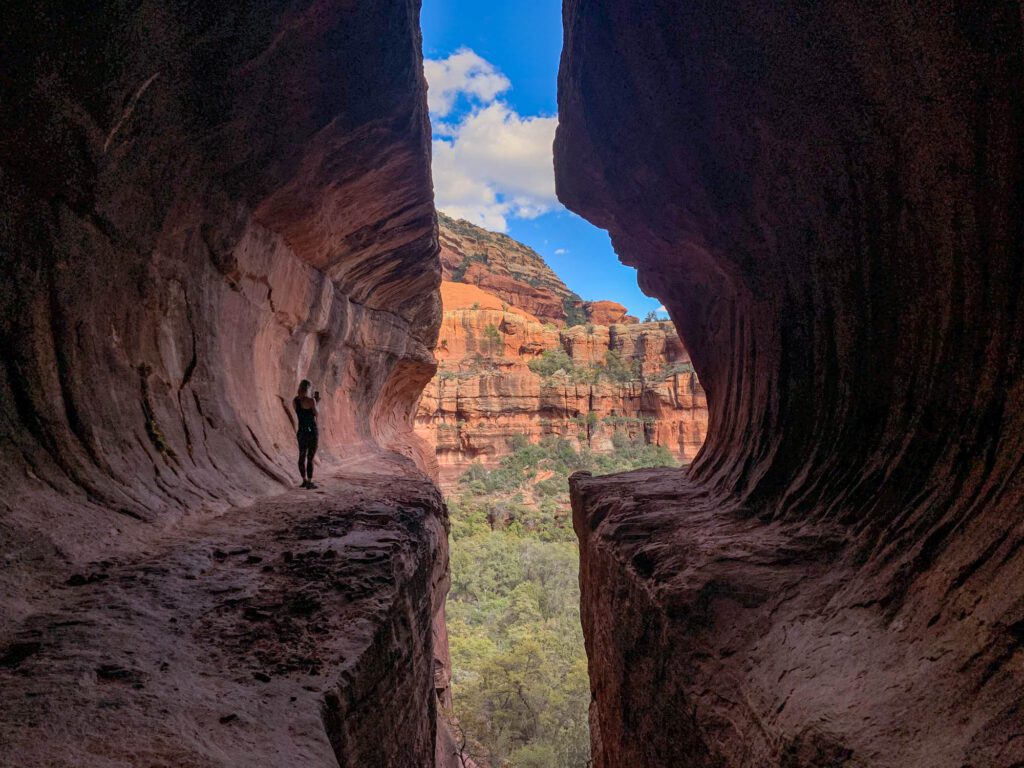
Disclaimer: Some of the links in this post, like hotel links, are affiliate links, meaning at no additional cost to you, we make a little bit of money if you click through and book. That being said, we would never recommend something to you that we don’t stand behind 100%.
How Many Days in Arizona?
Arizona is huge, and if you’re trying to hit all of the different corners of the state, you’ll need at least two weeks.
If you have less than that, we’d strongly recommend focusing your Arizona road trip itinerary on three main areas: Phoenix and the Superstition Mountains, Sedona, and Grand Canyon National Park.
You will need at least seven days – more would be better – to do Phoenix, Sedona, and the Grand Canyon.
We’ve written the road trip itinerary below for seven days, but have suggestions for what to do with extra time that are equally as detailed as the 7 day itinerary below – you can find them at the end of this guide.
- With a few extra days – 10 or so – you can add on Tucson and Saguaro National Park.
- With 14 days, add the southern loop through Tucson, plus Page and Zion National Park, ending your time by flying out of Vegas.
Monument Valley, which is spectacular, is FAR from most of the places on this itinerary. For example, it’ll take you three to four hours to get there from the Grand Canyon.
Other than the drive, which is beautiful, there’s nothing else to really do there, so we don’t think it really makes sense to take a huge detour to get there. In fact, it would be a better addition to a broader Arizona / Utah road trip on your way to Moab.
Instead, we’d STRONGLY recommend focusing your time on the corridor between Phoenix and the Grand Canyon, immersing yourself in the spectacular landscapes along the way rather than spending all day in the car.
Where to Start and End Your Arizona Road Trip
For most people, a loop that starts and ends in Phoenix, Arizona is going to be the best way to do this road trip.
Fly into Phoenix Sky Harbor International Airport, which generally has a good selection of flights from around the country (and even the world, in some cases). Click here to check flight prices into Phoenix’s Sky Harbor International Airport for your dates.
The benefit of doing this as a loop is that you won’t have to pay a one-way rental car fee.
From the furthest points on the itinerary below – either Page or the Grand Canyon South Rim – it’s about a four hour drive back to the airport.
Plan on booking the earliest possible flight into Phoenix, and the latest possible flight out to maximize your time.
Note: The exception to doing this as a loop is if you have 14 days and decide to add on Zion National Park at the end. Then, it would actually be better to end in Las Vegas – about two and a half hours or 172 miles from Zion.
Do You Need to Rent a Car for this Road Trip?
In short, yes. You’ll need to rent a car for the entirety of this itinerary. We’d recommend picking up and dropping off at the same place – Sky Harbor International Airport in Phoenix – to avoid a one-way rental car fee if you can.
We like using Kayak for booking rental cars because they aggregate all the different car rental sites to help you find the best price. Make sure to rent from a reputable company – Hertz, Enterprise, National, or Avis, which you can do by using Kayak’s helpful filters. Click here to check prices for rental cars in Phoenix.
A Complete 7 Day Itinerary for a Road Trip in Arizona
Now that we’ve got all the logistics out of the way, time to get into the exact itinerary we’d recommend.
Day 1: Fly in and Explore Phoenix
A lot of people pick up their rental car and head straight for either Sedona or Tucson, depending on what route you’re taking.
However, we think there are a few things to do in Phoenix that are well worth a day of your time.
We’d spend your first day, night, and second day in the Phoenix area, focusing on the many outdoor activities nearby, most notably the Superstition Mountains, which were a highlight of our Arizona trip. Then, on your second night, head up to Sedona and sleep there so you can get an early start the next morning.
What to Do in Phoenix
There are a couple of things worth doing in Phoenix itself on your first day in Arizona – we’ll cover the Superstition Mountains on day 2 of this itinerary.
- The Desert Botanical Garden in Papago Park is worth a stop to see all sorts of desert flora – over 50,000 different kinds! There are multiple loops that take you on a journey through the plant life of the Sonoran desert, which will give you a great foundation for the rest of your trip (“Hey Alysha! It’s a teddy bear cholla cactus!”).
- Speaking of Papago Park, Hole in the Wall is a short climb that takes you to a perfect spot to take in your first Arizona sunset! Unlike places on the west coast, there’s no marine layer or clouds in the sky to ruin the evening glow – sunsets in Arizona are spectacular.
- There are a surprising number of great hikes within 45 minutes of Phoenix. Camelback Mountain is seemingly right in the middle of town, and gives you sweeping views of the surrounding area from the summit, which is reached with a 2.5 mile out-and-back trail that is basically straight up. Tom’s Thumb is another great hike that takes you to a saddle with panoramic views – it’s a little further out to the north of town, but is worth the journey in our opinion.
- Get coffee at Cartel Coffee Lab, who has the best coffee in Phoenix (in our opinion, anyway) and has created a mini empire in southern Arizona.
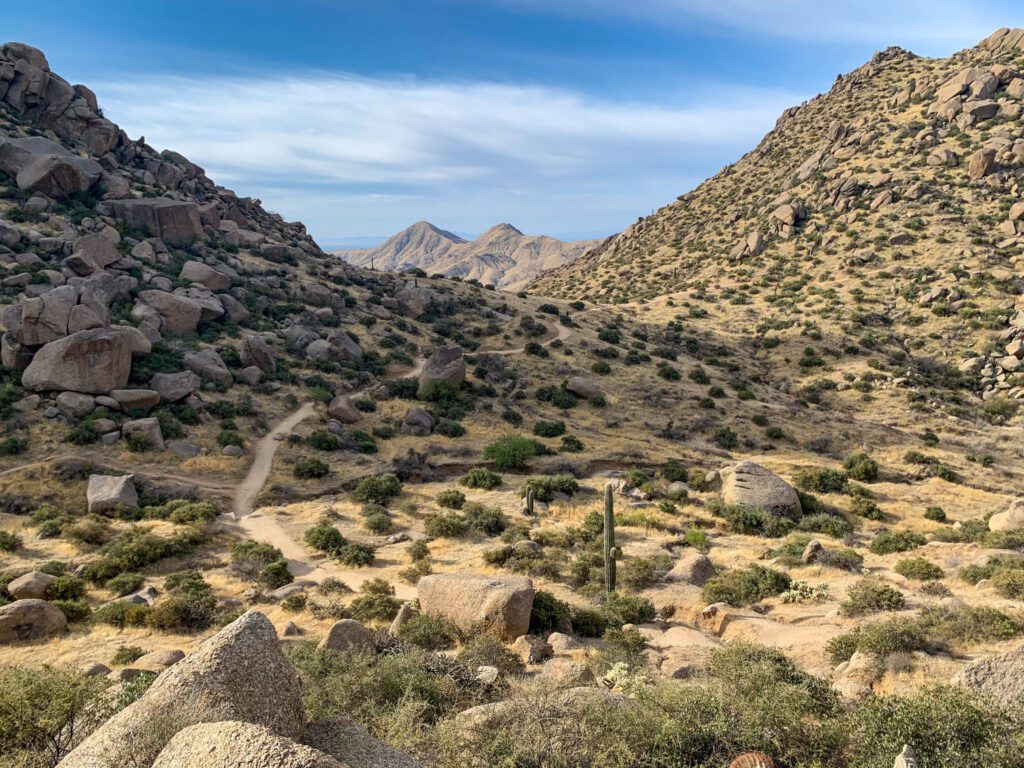
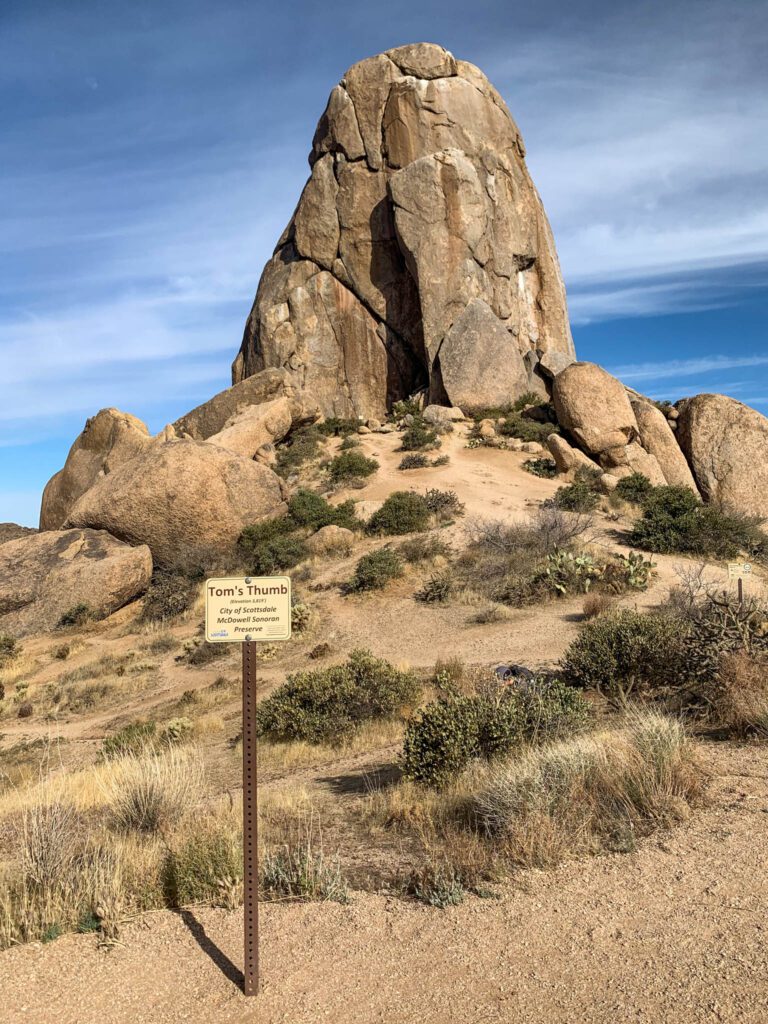
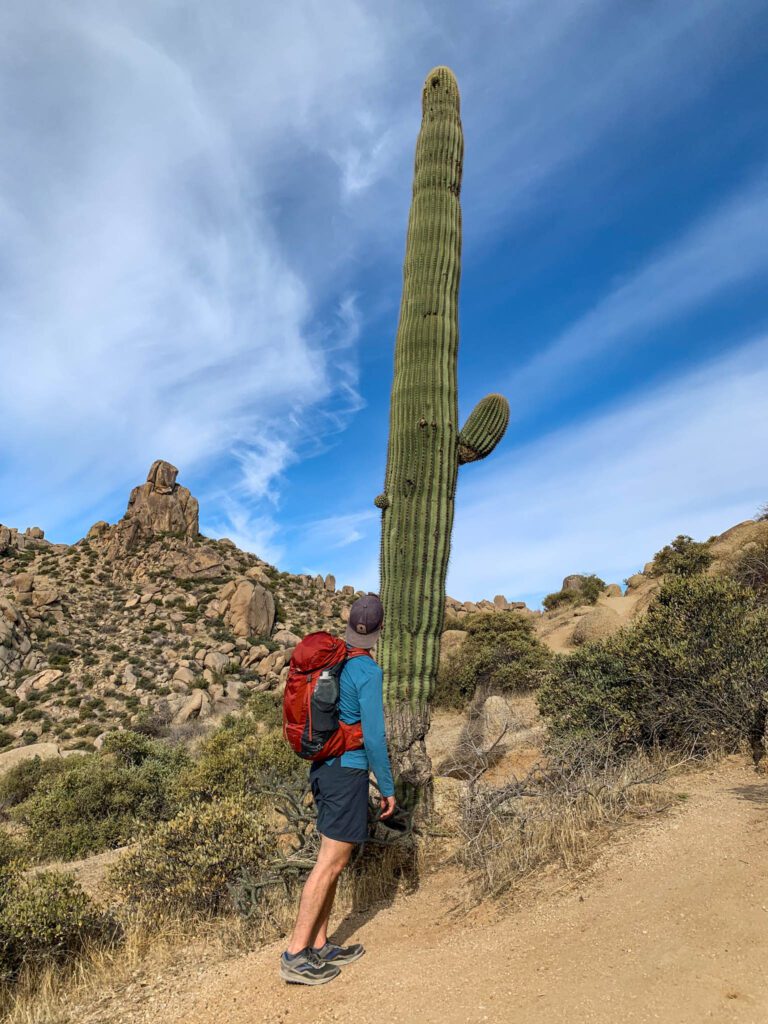
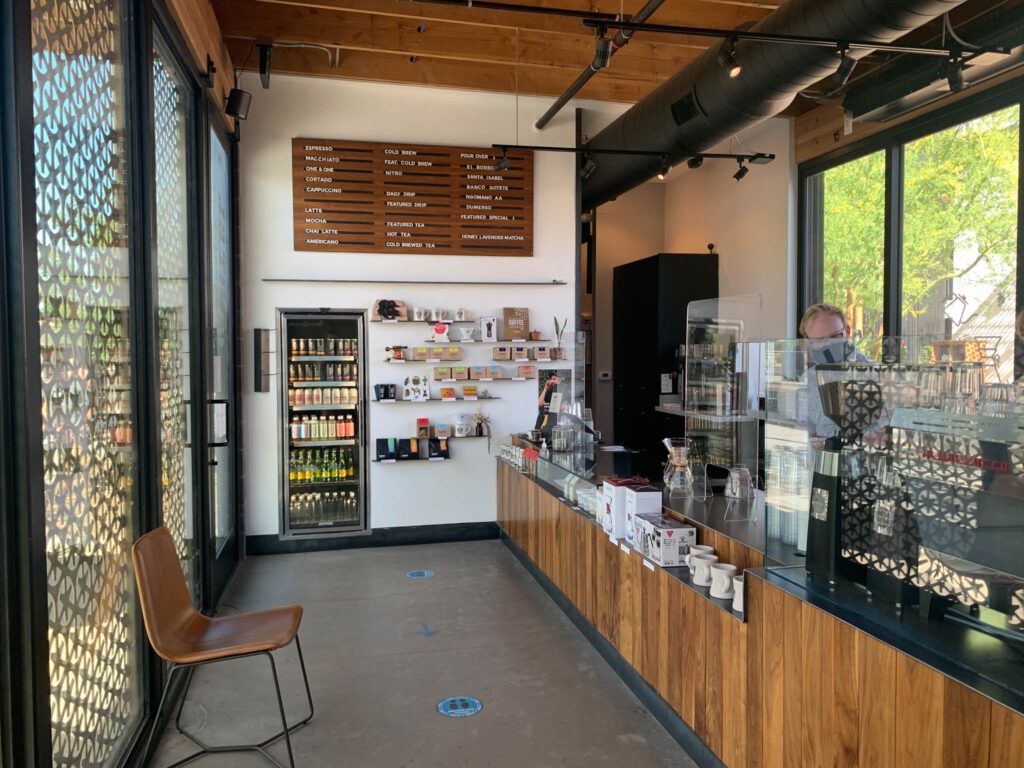
Where to Stay in Phoenix
We were walking through Uptown Phoenix on our way to Cartel Coffee – some of the best coffee in Phoenix – when we found ourselves in the courtyard of a hip-looking hotel.
That hotel was Rise Uptown, and we wish we would have stayed there. It’s a great location for exploring Phoenix, and the rooms are spacious and beautiful. Plus, there’s a nice pool, and Cartel Coffee is essentially in the lobby.
In general, we’d recommend staying somewhere between Downtown and uptown, between the two highways that run north-south (51 and 17).
Here are a couple of other good choices in Phoenix.
- Cambria Hotel Downtown Phoenix: Great value with bright-colored rooms and charming décor. Plus, it’s super affordable! It’s also near the freeway that you’ll take out to the Superstitions, which puts you in a great location for exploring.
- Aloft Phoenix Airport: Location is nothing special, but it’s convenient for the airport, and it’s an affordable choice with nice rooms and a pool.
- The AC Hotel Phoenix Biltmore: A little more on the boutique end of the spectrum, this hotel is beautiful, and is well-located in the Biltmore area of Phoenix, which is a perfect home base for exploring the city and surrounding area.
Day 2: Day Trip to the Superstition Mountains
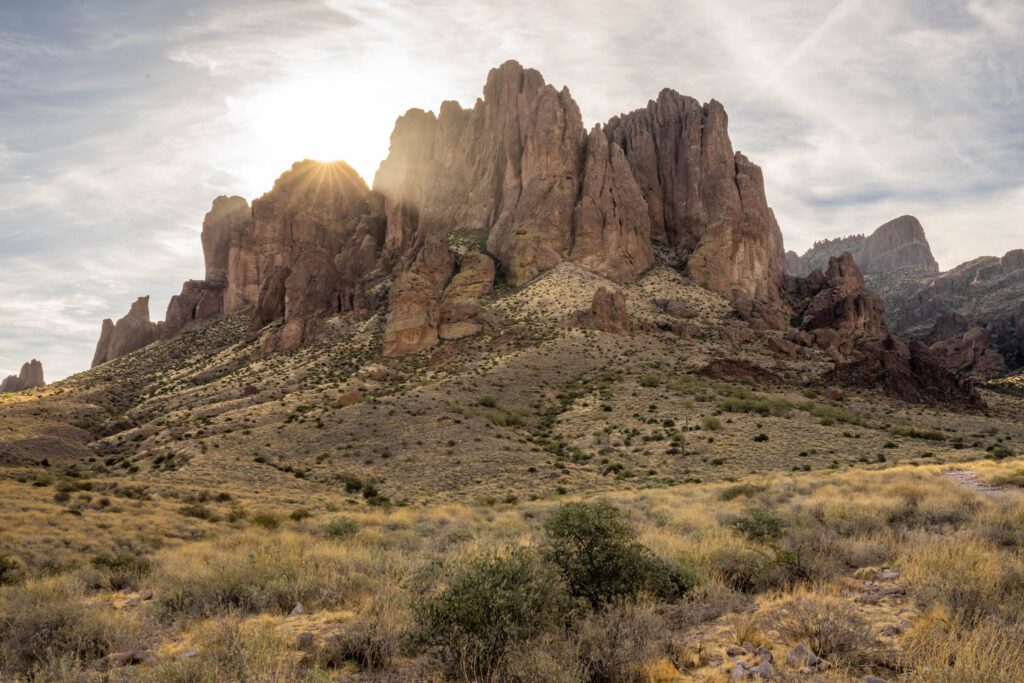
Stay in Phoenix for the night, and head out early to the east, where you’ll find the Superstition Wilderness, a highlight of our time in Arizona. You can explore most of the main part of the western end of the park in a morning, which is exactly what you’re going to do here.
Head to Lost Dutchman State Park, which will be your base for exploring, and park at either the Treasure Loop or Siphon Draw Trailheads. There’s a day use fee of $10 to enter the park.
There are a couple of established hikes in the park, but we created our own by putting together multiple hikes into one big loop.
Start with the eastern part of the Treasure Loop Trail, which winds its way up to the ridge. From there, rather than heading back down via the Treasure Loop Trail, take the Prospector’s Ridge Trail to the west until it intersects with the Siphon Draw Trail. From that intersection, take the Jacob’s Crosscut trail back to the trailhead.
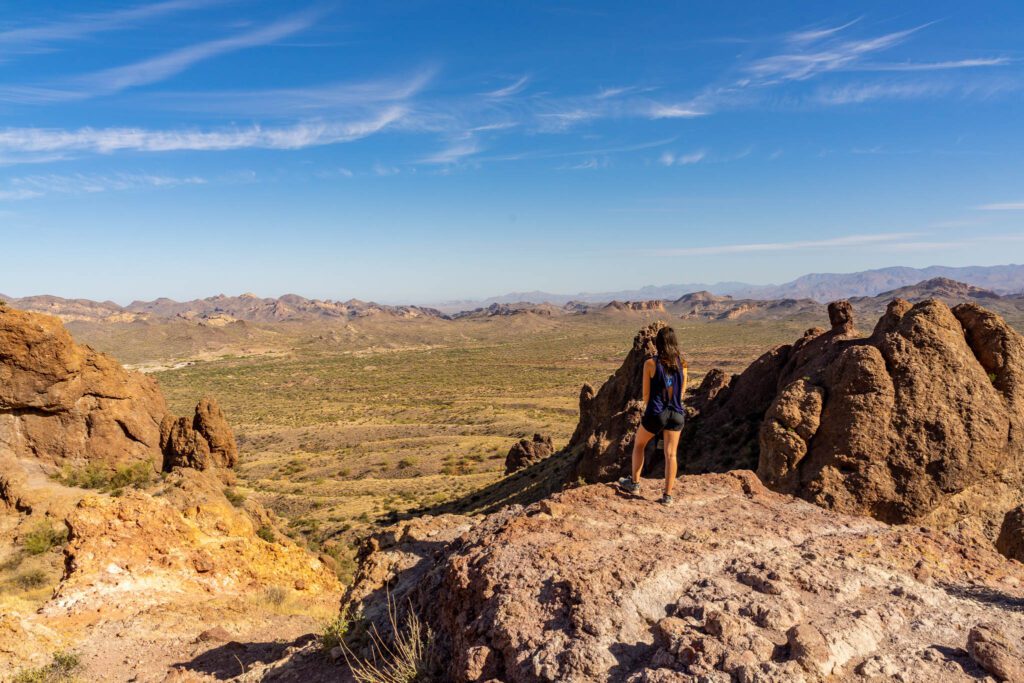
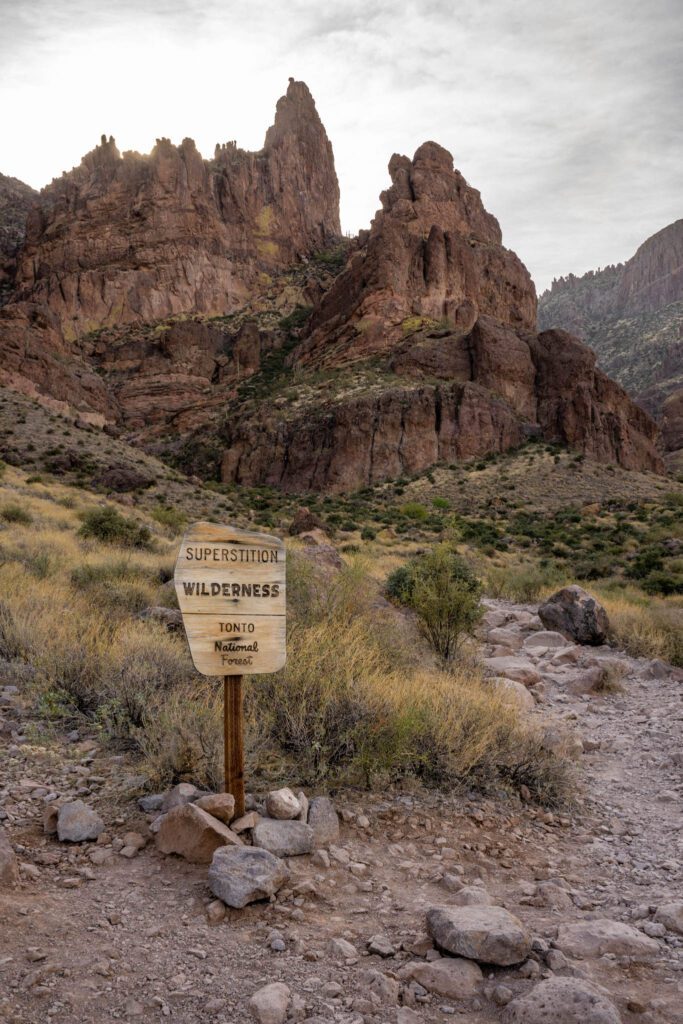
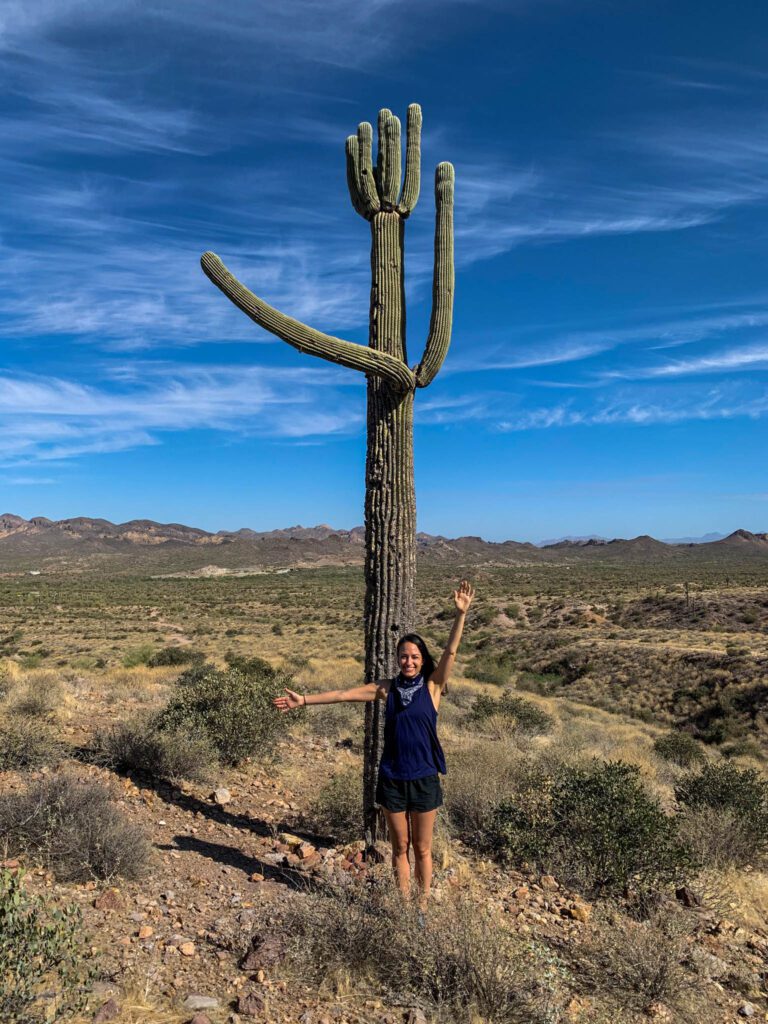
All-in, it’ll be around four miles, and you’ll see the Superstition Mountains and a ton of desert flora and fauna along the way.
On your way back into Phoenix, stop in Mesa, Arizona for a couple of our favorite spots in the Phoenix Metro Area.
- Get coffee at Mythical Coffee, which is actually in Gilbert, but is roughly on the way. This is the best coffee in the Phoenix area, we think. An alternative would be Peixoto Coffee, which we like because they own a coffee farm in Brazil (or more accurately, are owned by a family who also owns a coffee farm in Brazil) and highlight the coffees from their farm in their shop.
- Need to refuel post-hike? There are two great gluten free spots in Mesa, which we’d recommend whether you have Celiac Disease (like me) or not. First is Spooky Swirls, a cupcake shop (they make all sorts of baked goods) that makes fun, themed cupcakes that are not only beautiful, but they’re also delicious. We got a Baby Yoda cupcake (see below), that didn’t quite survive the Arizona heat, but was delicious either way. The second spot is Intentional Foods Cafe, which is a 100% gluten free restaurant that is also free of eight other allergens, so it’s perfect if you or any of your traveling companions have food sensitivities. Get the donuts and the fries.
- Last, but certainly not least, head up to Cider Corps, a veteran-owned cidery in Mesa to try some local cider. I believe (I could be wrong) that they are Phoenix’s only cider bar! They have a nice outdoor patio if it’s cool enough, otherwise they have a high-ceilinged, light-filled indoor space. Plus, CIDER SLUSHIES! You can bring outside food, so we’d recommend grabbing lunch and heading here to eat and sip on some cider.
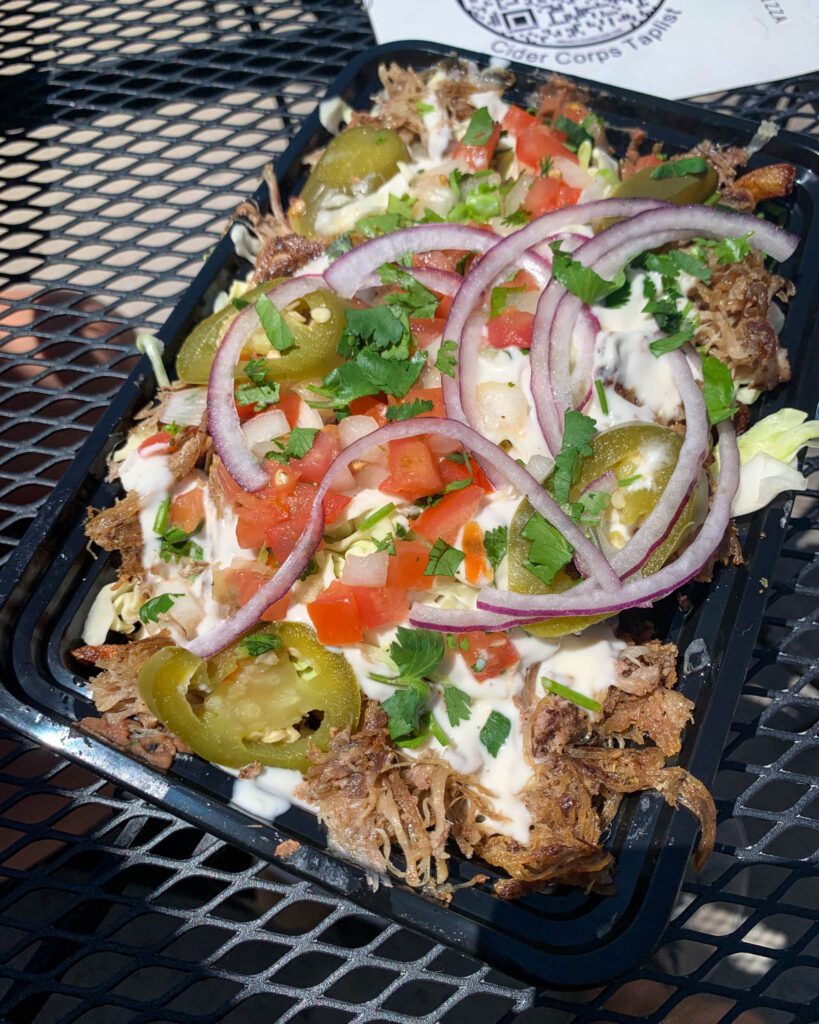
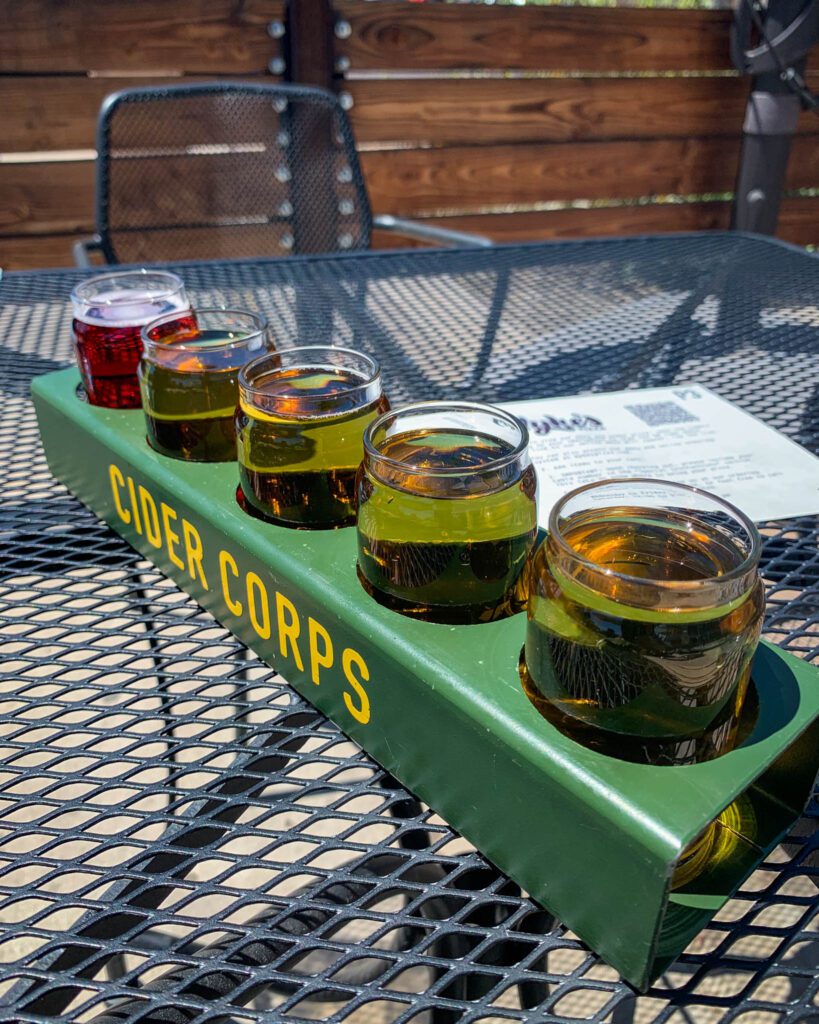
Days 3 & 4: Sedona
Drive Time from Phoenix: 2 hours / 115 miles
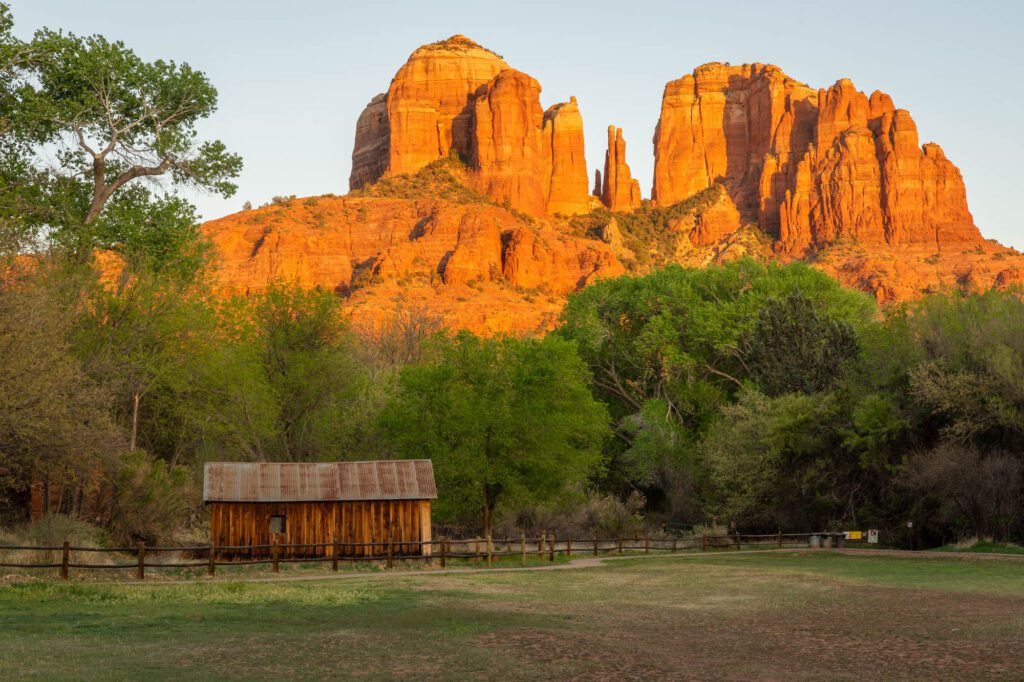
Sedona is gorgeous. We did Sedona and Zion on the same trip (see our recommendations for 14 days below to see how we did it), and in a lot of ways, they’re very similar. You’ll find red rock walls and towering buttes with lush greenery in the canyons below.
Another thing that makes them similar? The crowds.
We were in Sedona in April, and it was a zoo. Think hundreds of cars parked at the most popular trailheads, and roads to trailheads closed because the trailhead is full.
Still, it’s a beautiful place, and as long as you know what you’re getting into before you get there, you’ll enjoy your visit.
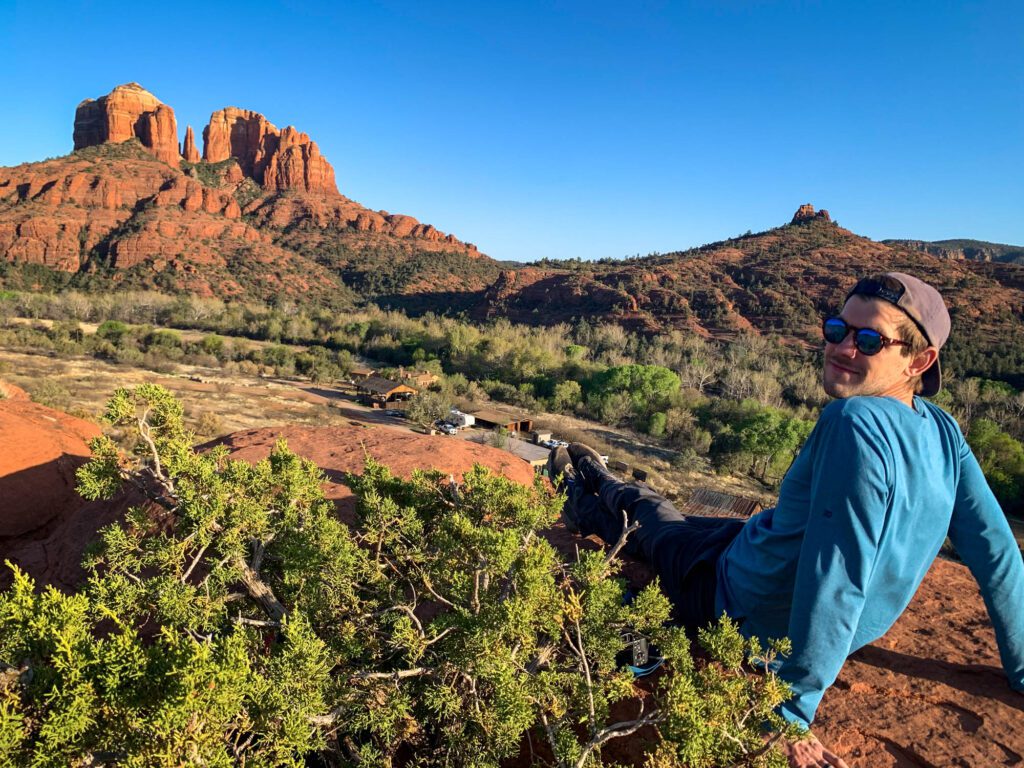
What to Do in Sedona
Sedona, like Bend, Oregon, is an outdoor lover’s paradise. There’s all sorts of fantastic hikes (psst! We have a guide to our favorite hikes in Sedona), 4×4 offroading, areas to spend a summer day lounging at the river, and more. Here are some of our favorite things to do in Sedona.
Crescent Moon Picnic Area: At this park on the south side of town, you’ll have some of the best views of Cathedral Rock that you’ll find anywhere in Sedona. Plus, there’s a river, so bring a picnic, a blanket and some towels, your swimsuit, and make an afternoon of it.
Drink Mind-blowing Chai at the Chai Spot: This was unexpected. As I was scrolling Google Maps getting myself oriented, I realized that there was a chai shop in Sedona called the Chai Spot. Not only do they make INCREDIBLE chai (get the butter chai, it’s creamy and rich and delicious), but their story is worth looking into as well. It’s a social project that focuses on economic empowerment of women and education of children in Pakistan. The inside of the shop is colorful and vibrant, and the outdoor patio is a welcome refuge from the heat – it’s the perfect spot for chai lovers (like Alysha) to relax in Sedona.

Hiking in Sedona: There are an incredible number of great hikes in Sedona. So many, that we have a whole separate post highlighting the best hikes in Sedona – if you want to spend most of your time on the hiking trails, you should absolutely go read that. We really enjoyed the West Fork of Oak Creek, which is a beautiful meander through a lush canyon with towering red rock walls. You cross the river 13 times, but none of the crossings are particularly hard, especially if you have waterproof shoes on. The Boynton Canyon Trail and Soldier Pass Trail were our next two picks, though you need to read our hiking guide to figure out the parking situation for Soldier Pass, which is a bonafide nightmare. Devils Bridge is cool, but you’ll probably have to wait in line at the top for a picture, which isn’t our cup of tea.
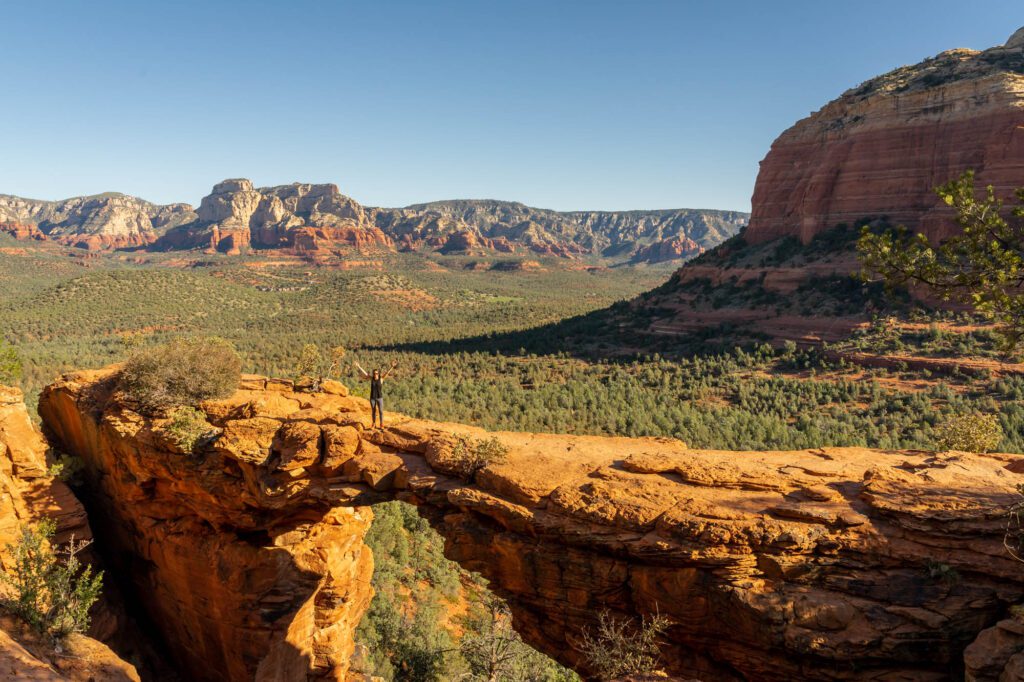
Sunset Spots: Arizona sunsets are amazing. Catch sunset at Airport Mesa, which is one of the most popular spots (there were literally hundreds of people there when we were there) or the top of Cathedral Rock, which requires a steep hike to reach. Another good option that should be less crowded is Bell Rock. Make the climb about halfway up the south side of the towering rock formation and find a nice spot to relax and watch the sun dip below the horizon. It’ll light up the red rocks of the valley in front of you as it does.
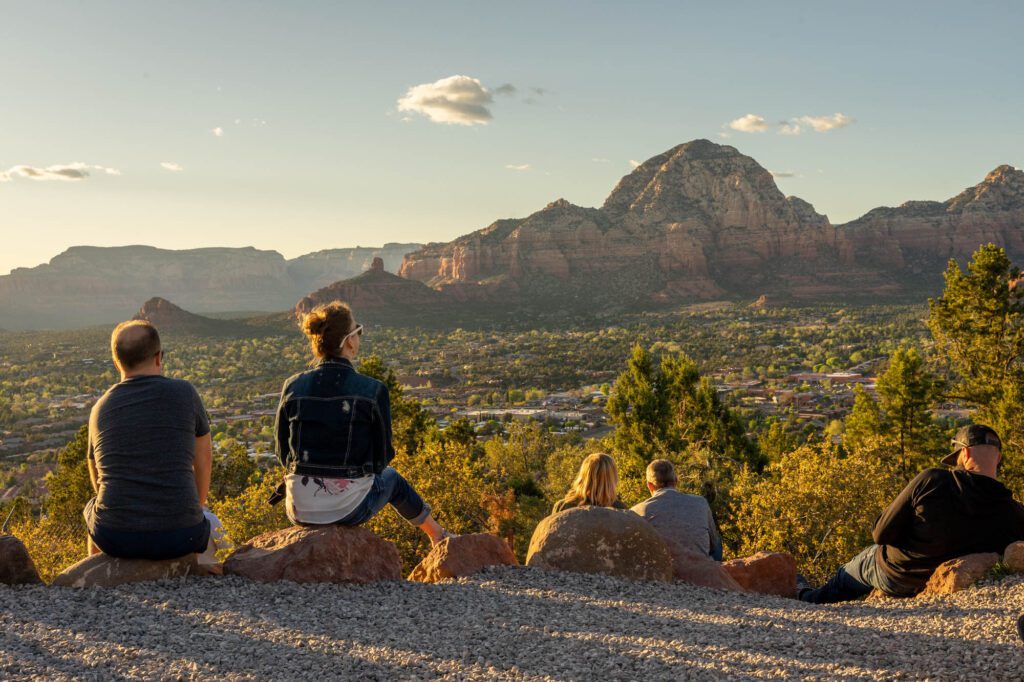
Wine Tasting: I bet you didn’t expect to see wine tasting on an itinerary for Arizona, did you? The Verde Valley Wine Trail is just outside of Sedona, in nearby Cottonwood and Corndale (~30 minutes from Sedona by car) and a trip out there would make for a great afternoon activity after a morning hike. Head to Oak Creek Vineyards for wine flights and small plates (also dog + kid friendly!), or Arizona Stronghold Vineyards (no reservations, tables are first-come-first-served) for a delightfully rustic tasting experience just outside of Cottonwood. If you don’t want to make the journey out of town, head to Art of Wine in Sedona and get a flight of the Arizona reds or whites, depending on what you’re into.
Where to Stay in Sedona
There are a couple of options in Sedona in terms of style and budget. You could stay in a hotel or resort, which will give you a nice refuge from the heat if you’re visiting in the summertime (or the cold if it’s winter or early spring). Or, you could camp at one of the campgrounds along 89A just north of Sedona.
Hotels in Sedona
If you’re looking to stay in a hotel, you’ve got a pretty impressive number of options.
We like Sky Ranch Lodge, which is walkable to the best sunset spot in the area at Airport Mesa. It’s where we’d stay if we were planning a trip to Sedona and weren’t living in our van.
They have a beautiful, lush property that has a patio with a great view of Sedona, and rooms are spacious. Plus, they’re certified sustainable by the Sustainability Alliance of Arizona!
Plus, a free shuttle to areas within five miles of the hotel means you won’t have to deal with parking at some of the most popular trailheads like the Soldier Pass Trail (though you should be careful, because cell-service is nonexistent in some parts of Sedona). It’s also walkable from the airport, which is a nice bonus if you’re flying in.
The other spot we’d recommend looking at is Junipine Resort, which is along 89A north of town and offers a quieter, more private place to stay. We drove past it on our way to our campground and were intrigued. Sure enough, it looks like an amazing place to stay!
It’s along the banks of Oak Creek, they’re certified sustainable, and they have “Creekhomes” that have plenty of space and a full kitchen. It’s only 10-15 minutes outside of Sedona, and is perfect if you’re in search of a bit of tranquility, which you might not find if you’re staying in downtown Sedona.
Camping in Sedona
If you want to camp, there are a bunch of campgrounds north of Sedona along Highway 89A. We’ll cover three of them, starting with the closest to Sedona and ending with one that’s about 15-20 minutes outside of town that we stayed at and really liked.
Manzanita Campground: Right along the creek in a nice shady spot, this is the closest campground to town, which also means it’s the most competitive. There are only 18 sites, 11 of which are reservable in advance. Seven sites are first-come-first-served, so plan on getting there early in the day to secure a spot. More info here.
Cave Springs Campground: With 84 sites, this is the biggest campground in the area. You must make reservations in advance (at least three days before you show up), and there’s usually availability (though we’d recommend grabbing a spot well in advance for the month of April, which is high season in Sedona). More info here.
Pine Flat Campground: This is the one we stayed at, and 18 of the 54 sites here are reservable in advance. It’s a nice campground, though it is right along the road (though all of them are, really). Try to get a site on the side of the campground that’s along Oak Creek – that’s on the west side of the road, and the west side of the campground (look at a map and you’ll see what I mean). More info here.
Days 5 & 6: The Grand Canyon
Drive Time from Sedona: 2 hours / 115 miles
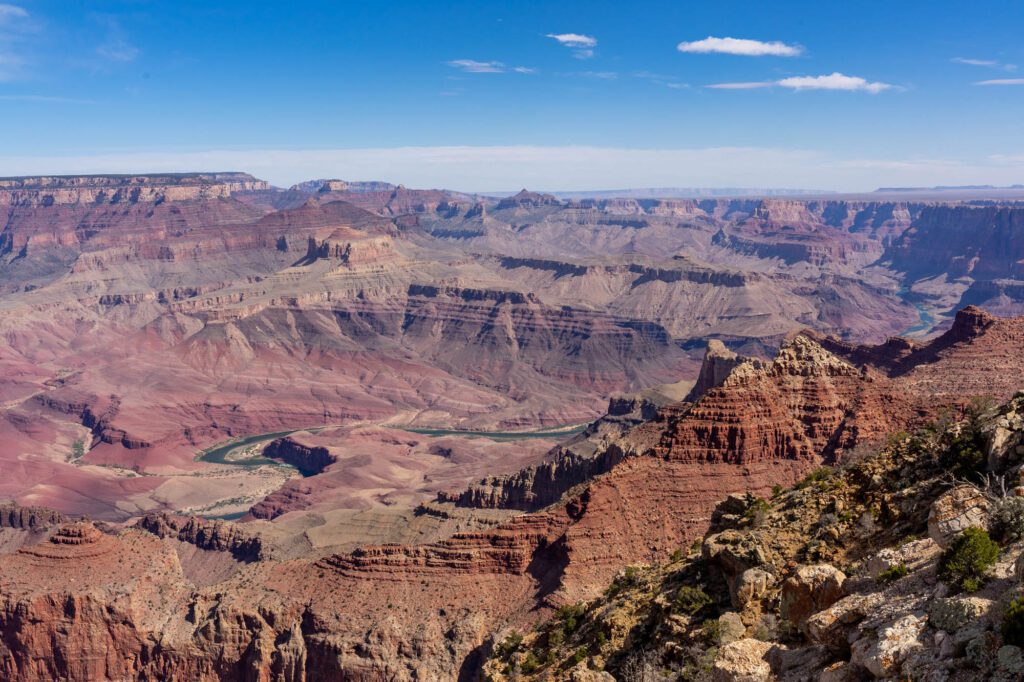
We think 2 days in the Grand Canyon is the perfect amount of time to explore the rim, take the scenic drive out to the East Entrance of the park and Desert View, and do one of the difficult but spectacular hikes that take you below the rim.
There’s plenty to do and see to fill a few more days if you have extra time on this road trip and you’re particularly interested in the Grand Canyon – like the North Rim, or backpacking to the floor of the canyon – but we think your time is actually better spent elsewhere unless you’re up for a long drive around to the North Rim, or a long overnight backpacking trip.
So spend a couple of days exploring the South Rim of the Grand Canyon, which is plenty of time to see the highlights.
What to Do in Grand Canyon National Park (South Rim)
Like we mentioned above, there are three things we think are “must-do” at the South Rim of the Grand Canyon.
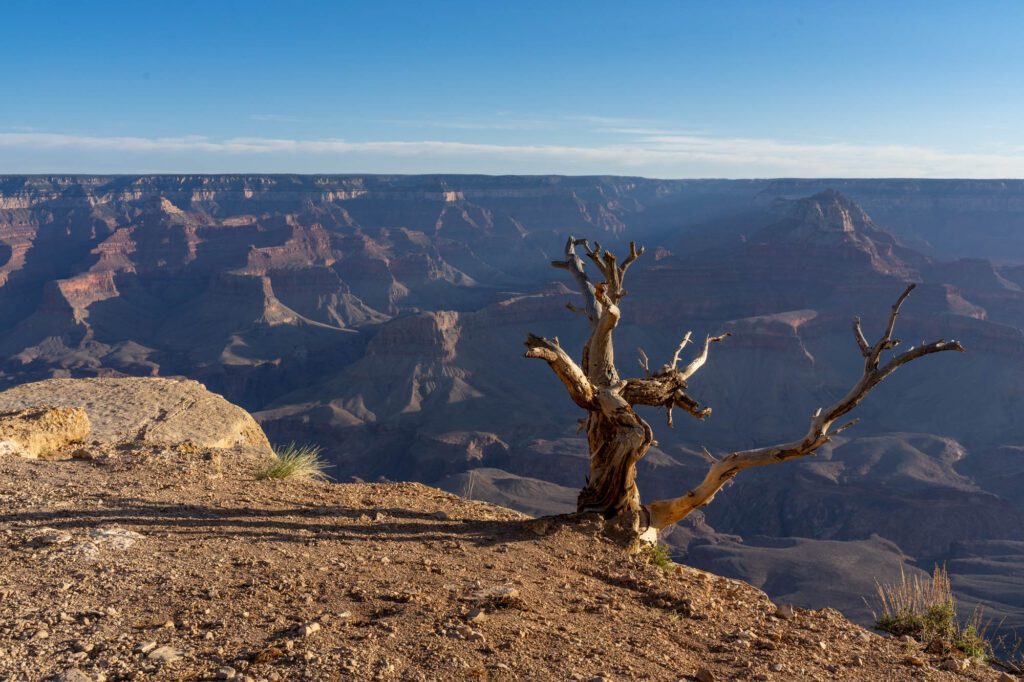
- Hike the Rim Trail: All along the Rim Trail, you’ll have spectacular and ever-changing views of the vastness of the canyon below. We like the stretch from Mather Point to the Bright Angel Trailhead, which is a 3.1 mile hike that is mostly flat with plenty of viewpoints along the way. Don’t miss Mather Point, Yavapai Point, and the Yavapai Geology Museum. This hike is best done in the early morning before 10am, which is when the crowds start to show up, or within an hour of sunset for stunning light on the canyon.
- Scenic Drive out to Desert View: This drive is amazing, with about a half-dozen viewpoints that are worth stopping at along the way. You’ll have a different perspective on the canyon from the eastern end, and it’s the only part of the rim road that you can drive in a private vehicle (except between December and February, when the road out to Hermit’s Rest is open to private vehicles). Start two hours before sunset, stopping at the viewpoints along the way, and ending at Desert View to take in the usually-stunning Arizona sunset.
- Get below the Canyon Rim: Like Bryce Canyon, one of our favorite national parks in the United States, the best way to really get a feel for the Grand Canyon is to hike down into it. You’re sure to appreciate the scale of the canyon if you have to make the climb up the canyon walls, gaining several thousand feet over the course of your journey! The two most popular trails are the South Kaibab Trail and the Bright Angel Trail. The Bright Angel Trail is more of a way to get all the way to the canyon floor, which you won’t be able to do in a day hike. We’d recommend taking the South Kaibab Trail out to Skeleton Point, which is 6 miles roundtrip with an elevation gain of 2,000 feet on the way back. Shorten it to 3 miles / 1,100 feet by turning around at Cedar Point instead.
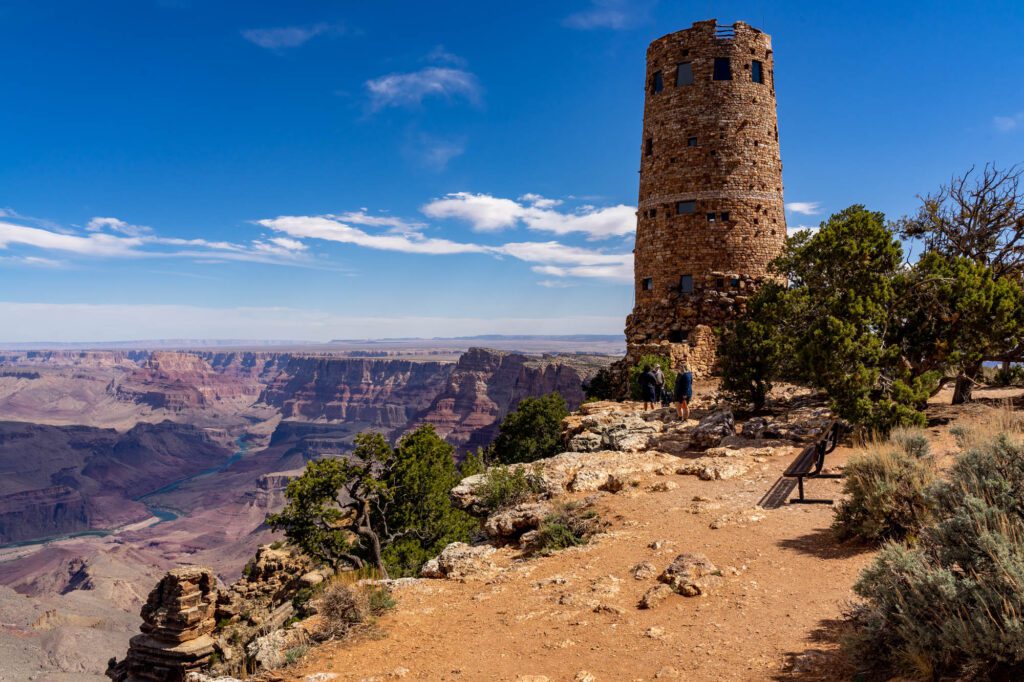
The hikes below the rim are not for the faint of heart – you’ll need to be prepared with plenty of water, sun protection, and salty snacks.
The interior of the canyon is often 20+ degrees hotter than the rim, which means you’re going to be at risk of heat exhaustion and dehydration, particularly in the summer months. Do not underestimate the difficulty of these hikes.
It’s probably better to underestimate your abilities rather than overestimating them, in this case.
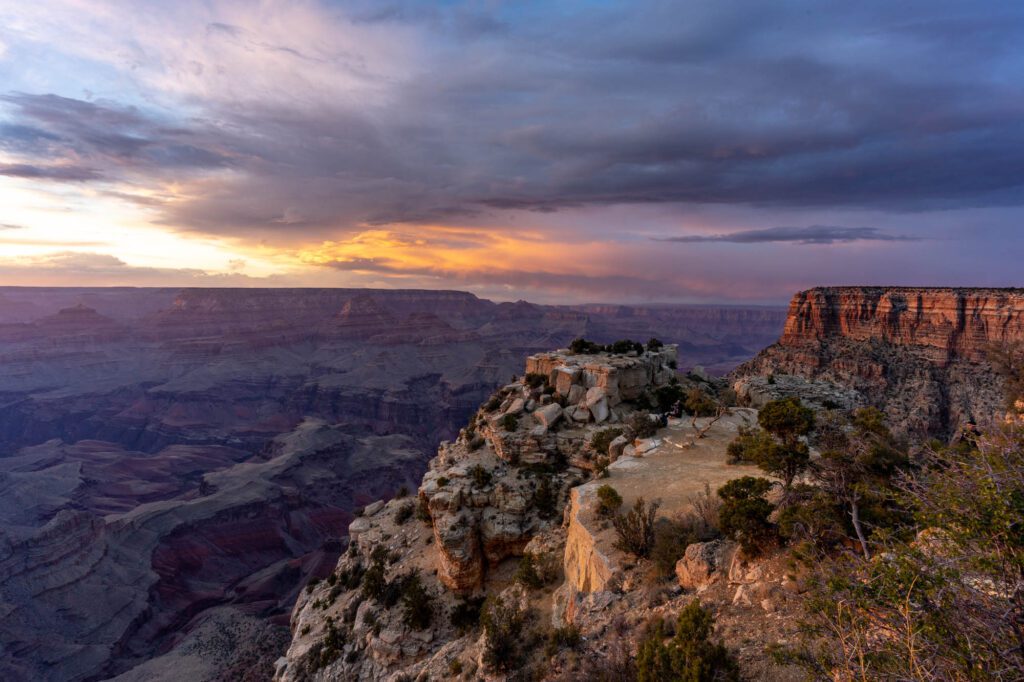
Where to Stay in the Grand Canyon
There are three places we’d recommend staying on the Grand Canyon’s South Rim, and it largely depends on your budget and style.
If you’re camping, stay at Mather Campground, which is within walking distance (~1 mile one-way) of the main Visitors Center and the Marketplace. We stayed here and although it’s a massive campground, it’s relatively nice with flush toilets, shaded sites, and good water. Honestly, we were surprised at how nice it was.
Staying inside the park on the Rim is a great option, but like most national parks, you’re going to pay a little extra for the convenience of having the Grand Canyon literally out your front door (in most cases). Along the rim, the best options are going to be El Tovar Hotel, the Bright Angel Lodge, and the Maswik Lodge.
Staying outside of the south entrance of the park (which is the best place to stay outside the park), is going to be cheaper, but means a little bit of a journey to get to the rim of the canyon, and often a line at the park entrance (though, not if you get there early enough!).
We’d recommend looking in the town of Tusayan (15 minutes from the rim), which is just outside the South Entrance, or Grand Canyon Junction (30 minutes to the rim), which has a better selection of places to stay, but is a little further out. Here are three places to check out:
- Under Canvas Grand Canyon (Grand Canyon Junction): Bucket list-worthy glamping! If you’re looking for a once-in-a-lifetime experience, check out their safari tents in the desert.
- Red Feather Lodge (Tusayan): Located a few minutes from the entrance to the park, this is a solid value with simple rooms in a perfect location. Plus, relatively affordable!
- Holiday Inn Express or Best Western Premier (Tusayan): Two well-rated, good value hotels just outside the south entrance. Not a whole lot of bells and whistles here, but a pleasant place to use as a home base for exploring the Grand Canyon.
Williams and Flagstaff will have you driving for an hour (or more) each way to and from the rim of the Grand Canyon, and we wouldn’t recommend staying there if you can avoid it.
Day 7: Drive to Phoenix & Fly Home
The drive back to Phoenix is going to take you about four hours from the Grand Canyon’s South Rim. Plan on booking an afternoon / evening flight to give yourself plenty of time for the drive back.
Longer Itinerary Options (10 & 14 Days)
If you have a full 10 days or even two weeks, you’ll unlock more possibilities for your trip.
Here’s how we would spend 10 days and 14 days in Arizona.
How to Spend 10 Days in Arizona
With 10 days, we think you should add on Tucson and Saguaro National Park on the front end of your road trip, and Page, Arizona on the tail end after the Grand Canyon.
For this version of the itinerary, pick up your rental car in Phoenix and head south to Tucson, where you’ll spend the first 2-3 days. Then, continue on the road trip above as written. On the second-to-last day, head up to Page.
Here’s what that looks like:
- Day 1: Fly into Phoenix, drive to Tucson
- Day 2: Tucson / Saguaro National Park
- Day 3: Tucson / Saguaro National Park
- Day 4: Drive to Phoenix, afternoon in Phoenix
- Day 5: Superstition Mountains, drive to Sedona
- Day 6: Sedona
- Day 7: Sedona + Drive to Grand Canyon
- Day 8: Grand Canyon National Park
- Day 9: Grand Canyon National Park + Drive to Page
- Day 10: Page + Drive to Phoenix + Head Home
Tucson and Saguaro National Park
Southern Arizona is a vastly different landscape than northern Arizona, which is what the 7 day itinerary above focuses on. With more time, you’ll be able to dip your toes in the southern Arizona water (just kidding, this is the desert!), but you won’t be able to see it all.
For your introduction to southern Arizona, we think you should focus on the area around Tucson.
What to Do in Tucson
There are two main focuses for your time in Tucson – Saguaro National Park (there are two parts!) and Mt. Lemmon.
Saguaro National Park
First, you should know that there are two parts of Saguaro National Park that straddle Tucson, one on either side. They are the Rincon Mountain District, which is on the east side of Tucson, and the Tucson Mountain District to the west.
Stop at the Visitor Center in each part of the park to grab a map, fill up your water, and get ready to explore. There is nowhere to get food or drinks other than water within the park, so you’ll want to pack a lunch and plenty of snacks.
Here are some things to do in each region of the park.
In the Tucson Mountain District, which is smaller in area but has a higher density of cacti and is therefore more popular:
- Drive the 5 mile Bajada Loop scenic drive, which is a loop consisting of Golden Gate Road and Hohokam Road. It’s unpaved, but is passable by all vehicles. Drive it counterclockwise, starting with Hohokam road and ending on Golden Gate. This is a great way to explore the park, especially if you make stops at the Valley View Overlook Trail (extend it a bit by combining it with the Wild Dog Trail) to get up close and personal with a ton of cacti, and the Signal Hill area, where you’ll find petroglyphs at the top of the hill.
- If you’re looking for a longer hike, do the hike up to Wasson Peak either from the Sendero Esperanza Trailhead (7.5 miles / 1,600 feet of elevation) or via the Hugh Norris Trailhead (8.9 miles / 2,400 feet of elevation gain).
- Stop at the Red Hills Visitor Center to walk the short loop through the cactus garden and pick up some maps and park information.
- The Desert Discovery Center, which is outside the park’s southern boundary, is worth a stop either on the way in or out to learn about all the flora and fauna in the desert.
In the Rincon Mountain District, which is the bigger but less popular part of the park on the east side of Tucson (If you only have time for one, we’d recommend the Tucson Mountain District. However, if you have time for both, this section of the park makes for a nice combination with Mt. Lemmon, since there’s only really about a half day worth of things to do and see here.):
- The number one thing you should do is drive Cactus Forest Loop Drive, which is a huge loop that takes you through the majority of the park. It is paved, and well worth the time. Stop at the Freeman Homestead Nature Trail, the Loma Verde Trail (do a loop with the Squeeze Pen Trail for a nice stroll through the desert), and the Cactus Forest Overlook.
- If you’re looking for a longer hike, there are a bunch of great options leaving from the Broadway Trailhead at the northwest corner of the park and the Douglas Spring Trailhead along the northern boundary.
Then, head to Mt. Lemmon for a completely different perspective on Tucson and the surrounding area.
At 9,159 feet above sea level, Mt. Lemmon is a completely different place than Tucson. It’s likely going to be 20-30 degrees cooler, which means different ecosystems thrive here on the highest peak in the Santa Catalina Mountains.
To put it in perspective, the average high temperature in July in Tucson is 100 degrees F. On Mt. Lemmon, it’s 76 degrees.
Would you believe me if I told you there’s a SKI RESORT on Mt. Lemmon?
You should definitely drive all the way to the top – Summerhaven. It’s 26 miles, and the landscape gradually shifts over the course of the journey. At the top, you’ll be in the woods. In Arizona. Which is an odd feeling when just an hour or two ago you were driving through Saguaro National Park, home of a bazillion cacti.
Stop by Windy Point Vista and San Pedro Vista on the way up for great views of the surrounding area.
There’s a bunch of things to do and see in the town of Summerhaven at the top, whether you want to hike or just peruse shops, but we think the drive itself is by far the best part about Mt. Lemmon.
If you’re looking for a great, relatively easy hike, head out to the Mt. Lemmon Fire Lookout Station. It’s 2.1 miles round trip with 360 feet of elevation gain, and you can make a nice loop of it by returning via the Meadow trail.
Where to Stay in Tucson
There are exactly zero campgrounds to stay at in Tucson, so your only options are going to be hotels and vacation rentals. Since you have two nights, you have your choice between staying in a hotel, which will provide more convenience and flexibility but less space, and vacation rentals, which give you more space and usually a kitchen, but less flexibility.
If you’re looking for a hotel, stay at Hotel McCoy, a cool hotel on the outskirts of town that’s perfect for exploring Saguaro National Park, or the Tuxon or the Graduate Hotel, which are both closer in to town and the amenities in Tucson.
Page, Arizona: Antelope Canyon & Horseshoe Bend
Page is a good home base for exploring two now Insta-famous sights in Arizona: Antelope Canyon and Horseshoe Bend.
I know Page as the jumping off point for renting a houseboat on Lake Powell, which my family has done twice now. Other than those three things, there’s not a whole lot going on, which makes it a perfect half-day addition after the Grand Canyon.
We’d recommend leaving the Grand Canyon on the afternoon of your last day to make it to Horseshoe Bend for sunset. Keep in mind, you’ll be with hundreds of your new closest friends – it’s a popular spot. You’ll need to get there early if you want a prime location.
Then, the next morning, get up early and head to Antelope Canyon. It’s on Navajo land, and is only accessible via guided tours, which take between one and a half to two hours. Grab an early 8am departure, which will give you plenty of time to head back to Phoenix afterwards and catch your flight home (or start the drive home, if you drove).
Where to Stay in Page
Stay at the Desert Canyon Inn, which is where we had booked a room before we had to cut our trip a bit short. They have basic apartments – complete with kitchens! – in a perfect location in downtown Page.
What to Do in Arizona With 14 Days
With a full two weeks, you’ve got options. At a high level, you could either make a big loop, including Monument Valley and Page, or you could tack on Zion National Park at the end of your trip, and fly out of Vegas.
For this itinerary, head south to Tucson first, then spend two days in Phoenix before heading up to Sedona, on to the Grand Canyon, then to Page for a night before heading to Zion National Park, which is technically in Utah, but close enough, right?
Note that we’re skipping Petrified Forest National Park and Monument Valley. It’s not that they aren’t cool and worth seeing. It’s that we think you’re better served focusing on western Arizona here, and making a return trip to explore eastern Arizona.
Otherwise, you’ll spend WAY too much time driving – and those drives are not particularly scenic, though there are some nice spots along the way – and not enough time actually exploring.
For reference, it’s going to take you four and a half hours to go from Tucson to Petrified Forest National Park, another three or more hours to go from there to Monument Valley, and another two hours to get to Page. All in the span of about 36 hours, because there’s really not that much to do along that route.
We think your time is better spent immersing yourself in Tucson, Sedona, and the Grand Canyon (and Zion). Some might disagree, but that’s our perspective.
Here’s what that itinerary looks like:
- Day 1: Fly into Phoenix, drive to Tucson
- Day 2: Tucson / Saguaro National Park
- Day 3: Tucson / Saguaro National Park + Mt. Lemmon
- Day 4: Phoenix
- Day 5: Superstition Mountains (sleep in Phoenix)
- Day 6: Sedona
- Day 7: Sedona
- Day 8: Sedona + Drive to Grand Canyon in evening
- Day 9: Grand Canyon National Park
- Day 10: Grand Canyon National Park
- Day 11: Page (Antelope Canyon morning + Horseshoe Bend sunset)
- Day 12: Drive to Zion
- Day 13: Zion
- Day 14: Drive to Vegas and Fly Home (stop at Valley of Fire if you have time)
Wondering what to do in Zion National Park? We’ve got you covered.
The Best Time to Road Trip in Arizona
Essentially, we’d say “anytime other than the summer.” But ideally spring and fall – March and April, and September and October being the best months.
We spent three weeks on this road trip in the spring in April, and it was very, very pleasant. In Phoenix, it’s still going to be warm, but not unbearable just yet – think 80’s and 90’s during the day. In higher elevation Sedona and the Grand Canyon, it’ll be slightly cooler, even downright cold in the Grand Canyon at night.
In the fall, it’s going to be similar, with relatively warm temperatures in Phoenix and southern Arizona that start to cool off as you head north into the higher elevation parts of the state.
The winter is also a decent time to visit, particularly in southern Arizona (Phoenix and Tucson). However, you could run into snow in Sedona and the Grand Canyon, which can put a damper on your trip.
Summer in Arizona is going to be borderline unbearable, with temperatures regularly over 100 degrees, and huge crowds of people – particularly families with kids out of school – flocking to places like the Grand Canyon. You’ll need to book things well in advance if you visit during the summer, and be prepared for incredibly hot weather.
More Arizona + Utah Travel Guides
If you liked this guide, you’re going to love our other Arizona and Utah travel guides.
Phoenix: Plan a perfect weekend in Phoenix, and figure out where to stay in Phoenix.
The Grand Canyon: Planning a trip that includes the Grand Canyon? We’ve got you covered with a guide on exactly how to plan an amazing Grand Canyon itinerary and how to find the perfect place to stay.
Sedona: Plan the perfect weekend getaway to Sedona, and learn everything you need to know to go hiking in Sedona.
If you’re making your way into Utah, you’ll want to read our guides to:
- Zion (2 day itinerary and where to stay)
- Bryce Canyon (the best hikes and how to spend one day in Bryce Canyon)
- Moab (a perfect itinerary, the best hikes in Arches, and the best places to stay and things to do)
Plus, our 10 day Utah National Parks road trip is a super detailed guide to exploring Utah, if you’ve got the time. Otherwise, save it for later.
